Construction Safety Management: Based on the Theoretical Approach of BIM and the Technology Acceptance Model
Abstract
1. Introduction
2. Methodology
3. Results and Discussion
4. Conclusions
4.1. Theoretical and Practical Implications
4.2. Limitations and Future Research
5. Recommendations
Author Contributions
Funding
Data Availability Statement
Acknowledgments
Conflicts of Interest
Abbreviations
| BIM | Building Information Model |
| TAM | Technology Acceptance Model |
| BI | Behavioral Intent |
| PU | Perceived Usefulness |
| PEOU | Perceived Ease of Use |
| ATU | Attitudes Toward Use |
| HI | Hazard Identification |
| SA | Safety Awareness |
| PUBIM | Perceived Usefulness of BIM |
| Exp | Extent to which stakeholders believe |
| BARR | Barriers to BIM Adoption |
| TR | Training and Education |
| OC | Organizational Culture |
| PE | Perceived Effectiveness |
Appendix A
| Q. Nos. | Question | Symbolic Representation | 1 | 2 | 3 | 4 | 5 |
|---|---|---|---|---|---|---|---|
| Strongly Disagree | Disagree | Neutral | Agree | Strongly Agree | |||
| 1 | Is Behavioral Intent (BI) to adopt BIM for safety management helpful for construction work? | BI | □ | □ | □ | □ | □ |
| 2 | Is Perceived Usefulness (PU) of BIM essential on a construction site? | PU | □ | □ | □ | □ | □ |
| 3 | Is Perceived Ease of Use (PEOU) essential on a construction site? | PEOU | □ | □ | □ | □ | □ |
| 4 | Are Attitudes Toward Use (ATU) essential on the construction site? | ATU | □ | □ | □ | □ | □ |
Appendix B
| Q. Nos. | Question | Symbolic Representation | 1 | 2 | 3 | 4 | 5 |
|---|---|---|---|---|---|---|---|
| Strongly Disagree | Disagree | Neutral | Agree | Strongly Agree | |||
| 1 | Is Hazard Identification (HI) essential for a construction Project? | HI | □ | □ | □ | □ | □ |
| 2 | Is the Perceived Usefulness (PU) the extent to which stakeholders believe BIM can help identify risks and reduce construction risks? | PU | □ | □ | □ | □ | □ |
| 3 | Is the Perceived Ease of Use (PEOU) the extent to which stakeholders believe BIM is easy to use for risk identification? | PEOU | □ | □ | □ | □ | □ |
| 4 | Is Safety Awareness (SA) being leveled at the stakeholder awareness of the safety protocols and risk reduction through BIM? | SA | □ | □ | □ | □ | □ |
Appendix C
| Q. Nos. | Question | Symbolic Representation | 1 | 2 | 3 | 4 | 5 |
|---|---|---|---|---|---|---|---|
| Strongly Disagree | Disagree | Neutral | Agree | Strongly Agree | |||
| 1 | What is the impact or importance of the Perceived Usefulness of BIM for safety management in the construction sector? | PUBIM | □ | □ | □ | □ | □ |
| 2 | Is Perceived Effectiveness of BIM in Risk Identification/Mitigation? | PEOU | □ | □ | □ | □ | □ |
| 3 | Is the Perceived Ease of Use of BIM tools the extent to which stakeholders believe BIM is easy to use for risk identification? | Exp | □ | □ | □ | □ | □ |
| 4 | How much does the impact of the Barriers to BIM Adoption (cost, technical complexity, lack of training) affect construction activities? | BARR | □ | □ | □ | □ | □ |
| 5 | Is Training and Education on BIM Safety Features essential on a construction project? | TR | □ | □ | □ | □ | □ |
| 6 | What is the Organizational Culture (support and willingness to adopt BIM) in the construction sector? | OC | □ | □ | □ | □ | □ |
| 7 | Is the Perceived Effectiveness (PE) of BIM in Risk Identification and Mitigation essential for the construction sector? | (PE) | □ | □ | □ | □ | □ |
References
- Cheng, E.W.L.; Ryan, N.; Kelly, S. Exploring the Perceived Influence of Safety Management Practices on Project Performance in the Construction Industry. Saf. Sci. 2012, 50, 363–369. [Google Scholar] [CrossRef]
- Zhou, Z.; Goh, Y.; Science, Q.L.-S. Overview and Analysis of Safety Management Studies in the Construction Industry; Elsevier: Amsterdam, The Netherlands, 2015. [Google Scholar]
- Jazayeri, E.; Dadi, G.B. Construction Safety Management. J. Saf. Eng. 2017, 2, 15–28. [Google Scholar]
- Wang, X.; Zhao, B.; Su, C. Assessing Safety Efficiency in China’s Provincial Construction Industry: Trends, Influences, and Implications. Buildings 2024, 14, 893. [Google Scholar] [CrossRef]
- Tam, C.M.; Zeng, S.X.; Deng, Z.M. Identifying Elements of Poor Construction Safety Management in China. Saf. Sci. 2004, 42, 569–586. [Google Scholar] [CrossRef]
- Segbenya, M.; Yeboah, E. Effect of Occupational Health and Safety on Employee Performance in the Ghanaian Construction Sector. Environ. Health Insights 2022, 16, 11786302221137222. [Google Scholar] [CrossRef] [PubMed]
- Neitzel, R.L.; Seixas, N.S.; Ren, K.K. A Review of Crane Safety in the Construction Industry. Appl. Occup. Environ. Hyg. 2001, 16, 1106–1117. [Google Scholar] [CrossRef] [PubMed]
- Zhou, Z.; Zhuo, W.; Cui, J.; Luan, H.; Chen, Y.; Lin, D. Developing a Deep Reinforcement Learning Model for Safety Risk Prediction at Subway Construction Sites. Reliab. Eng. Syst. Saf. 2025, 257, 110885. [Google Scholar] [CrossRef]
- Mol, T. Productive Safety Management; Taylor & Francis: London, UK, 2003. [Google Scholar] [CrossRef]
- Zhang, J.; Li, Y.; Fukuda, T.; Wang, B. Urban Safety Perception Assessments via Integrating Multimodal Large Language Models with Street View Images. Cities 2025, 165, 106122. [Google Scholar] [CrossRef]
- Qi, H.; Zhou, Z.; Manu, P.; Li, N. Falling Risk Analysis at Workplaces through an Accident Data-Driven Approach Based upon Hybrid Artificial Intelligence (AI) Techniques. Saf. Sci. 2025, 185, 106814. [Google Scholar] [CrossRef]
- Stenhoff, A.; Steadman, L.; Nevitt, S.; Benson, L.; White, R.; Hill, B. Deep Learning in the Construction Industry: A Review of Present Status and Future Innovations. J. Build. Eng. 2020, 32, 101827. [Google Scholar] [CrossRef]
- Torgal, F.P.; Jalali, S. Eco-Efficient Construction and Building Materials; Springer Science & Business Media: Berlin/Heidelberg, Germany, 2014. [Google Scholar] [CrossRef]
- Olutuase, S.O. A Study of Safety Management in the Nigerian Construction Industry. IOSR J. Bus. Manag. 2014, 16, 1–10. [Google Scholar] [CrossRef]
- Purohit, D.P.; Siddiqui, N.A.; Nandan, A.; Yadav, B.P. Hazard Identification and Risk Assessment in Construction Industry. Int. J. Appl. Eng. Res. 2018, 13, 7639–7667. [Google Scholar]
- Yiu, N.S.N.; Sze, N.N.; Chan, D.W.M. Implementation of Safety Management Systems in Hong Kong Construction Industry–A Safety Practitioner’s Perspective. J. Safety Res. 2018, 64, 1–9. [Google Scholar] [CrossRef]
- Zulkeflee, A.A.; Faisol, N.; Ismail, F.; Ismail, N.A.A. Qurtubi Reluctance to Change: Key Factors of Foreign Labours’ Safety Non-Compliance Behaviours. J. Constr. Dev. Ctries. 2024, 29, 23–41. [Google Scholar] [CrossRef]
- Guo, B.H.W.; Goh, Y.M.; Le Xin Wong, K. A System Dynamics View of a Behavior-Based Safety Program in the Construction Industry. Saf. Sci. 2018, 104, 202–215. [Google Scholar] [CrossRef]
- Hadikusumo, B.H.W.; Kulchartchai, O. Exploratory Study of Obstacles in Safety Culture Development in the Construction Industry: A Grounded Theory Approach. J. Constr. Dev. Ctries. 2010, 15, 45–66. [Google Scholar]
- Wan, A.; Gong, W.; AL-Bukhaiti, K.; Cheng, X.; Ji, X.; Ji, Y.; Ma, S. Data-Driven Early Fire Detection in Offshore Wind Turbines: A TCN-ECA Based Approach Leveraging SCADA Data. Process Saf. Environ. Prot. 2025, 200, 107373. [Google Scholar] [CrossRef]
- Harshit; Chaurasia, P.; Zlatanova, S.; Jain, K. Low-Cost Data, High-Quality Models: A Semi-Automated Approach to LOD3 Creation. ISPRS Int. J. Geo-Inf. 2024, 13, 119. [Google Scholar] [CrossRef]
- Tezel, B.A. Visual Management: An Exploration of the Concept and Its Implementation in Construction. Ph.D. Thesis, University of Salford, Salford, UK, 2011. [Google Scholar]
- Levin, D.Z.; Cross, R.; Abrams, L.C. The Strength of Weak Ties You Can Trust: The Mediating Role of Trust in Effective Knowledge Transfer. Acad. Manag. Proc. 2002, 2002, D1–D6. [Google Scholar] [CrossRef]
- Choe, S.; Leite, F. Construction Safety Planning: Site-Specific Temporal and Spatial Information Integration. Autom. Constr. 2017, 84, 335–344. [Google Scholar] [CrossRef]
- Bansal, V.K. Application of Geographic Information Systems in Construction Safety Planning. Int. J. Proj. Manag. 2011, 29, 66–77. [Google Scholar] [CrossRef]
- Martinez, J.G.; Gheisari, M.; Alarcón, L.F. UAV Integration in Current Construction Safety Planning and Monitoring Processes: Case Study of a High-Rise Building Construction Project in Chile. J. Manag. Eng. 2020, 36, 05020005. [Google Scholar] [CrossRef]
- Saurin, T.A.; Formoso, C.T.; Guimaraes, L.B.M. Safety and Production: An Integrated Planning and Control Model. Constr. Manag. Econ. 2004, 22, 159–169. [Google Scholar] [CrossRef]
- Hare, B.; Cameron, I.; Roy Duff, A. Exploring the Integration of Health and Safety with Pre-Construction Planning. Eng. Constr. Archit. Manag. 2006, 13, 438–450. [Google Scholar] [CrossRef]
- Hu, Z.; Chan, W.T.; Hu, H.; Xu, F. Cognitive Factors Underlying Unsafe Behaviors of Construction Workers as a Tool in Safety Management: A Review. J. Constr. Eng. Manag. 2023, 149, 03123001. [Google Scholar] [CrossRef]
- Saunders, F.C.; Gale, A.W.; Sherry, A.H. Conceptualising Uncertainty in Safety-Critical Projects: A Practitioner Perspective. Int. J. Proj. Manag. 2015, 33, 467–478. [Google Scholar] [CrossRef]
- Ranasinghe, U.; Jefferies, M.; Davis, P.; Pillay, M. Conceptualising Project Uncertainty in the Context of Building Refurbishment Safety: A Systematic Review. Buildings 2021, 11, 89. [Google Scholar] [CrossRef]
- Alkaissy, M.; Arashpour, M.; Ashuri, B.; Bai, Y.; Hosseini, R. Safety Management in Construction: 20 Years of Risk Modeling. Saf. Sci. 2020, 129, 104805. [Google Scholar] [CrossRef]
- Cao, K.; Chen, S.; Chen, Y.; Nie, B.; Li, Z. Decision Analysis of Safety Risks Pre-Control Measures for Falling Accidents in Mega Hydropower Engineering Driven by Accident Case Texts. Reliab. Eng. Syst. Saf. 2025, 261, 111120. [Google Scholar] [CrossRef]
- Sherratt, F.; Ivory, C. Managing “a Little Bit Unsafe”: Complexity, Construction Safety and Situational Self-Organising. Eng. Constr. Archit. Manag. 2019, 26, 2519–2534. [Google Scholar] [CrossRef]
- Ghaffarianhoseini, A.; Tookey, J.; Ghaffarianhoseini, A.; Naismith, N.; Azhar, S.; Efimova, O.; Raahemifar, K. Building Information Modelling (BIM) Uptake: Clear Benefits, Understanding Its Implementation, Risks and Challenges. Renew. Sustain. Energy Rev. 2017, 75, 1046–1053. [Google Scholar] [CrossRef]
- Cerovsek, T. A Review and Outlook for a “Building Information Model” (BIM): A Multi-Standpoint Framework for Technological Development. Adv. Eng. Informatics 2011, 25, 224–244. [Google Scholar] [CrossRef]
- Visartsakul, B.; Damrianant, J. A Review of Building Information Modeling and Simulation as Virtual Representations under the Digital Twin Concept. Eng. J. 2023, 27, 11–27. [Google Scholar] [CrossRef]
- Ding, Z.; Liu, S.; Liao, L.; Zhang, L. A Digital Construction Framework Integrating Building Information Modeling and Reverse Engineering Technologies for Renovation Projects. Autom. Constr. 2019, 102, 45–58. [Google Scholar] [CrossRef]
- Liu, D.; Lu, W.; Niu, Y. Extended Technology-Acceptance Model to Make Smart Construction Systems Successful. J. Constr. Eng. Manag. 2018, 144, 04018035. [Google Scholar] [CrossRef]
- Katebi, A.; Homami, P.; Najmeddin, M. Acceptance Model of Precast Concrete Components in Building Construction Based on Technology Acceptance Model (TAM) and Technology, Organization, and Environment (TOE) Framework. J. Build. Eng. 2022, 45, 103518. [Google Scholar] [CrossRef]
- Mitera-Kiełbasa, E.; Zima, K. Optimising Construction Efficiency: A Comprehensive Survey-Based Approach to Waste Identification and Recommendations with BIM and Lean Construction. Sustainability 2025, 17, 4027. [Google Scholar] [CrossRef]
- Salzano, A.; Cascone, S.; Zitiello, E.P.; Nicolella, M. Construction Safety and Efficiency: Integrating Building Information Modeling into Risk Management and Project Execution. Sustainability 2024, 16, 4094. [Google Scholar] [CrossRef]
- Liu, Z.; Lu, Y.; Peh, L.C. A Review and Scientometric Analysis of Global Building Information Modeling (BIM) Research in the Architecture, Engineering and Construction (AEC) Industry. Buildings 2019, 9, 210. [Google Scholar] [CrossRef]
- Zou, Y.; Kiviniemi, A.; Jones, S.W. A Review of Risk Management through BIM and BIM-Related Technologies. Saf. Sci. 2017, 97, 88–98. [Google Scholar] [CrossRef]
- Lin, Y.-C. Construction 3D BIM-Based Knowledge Management System: A Case Study. J. Civ. Eng. Manag. 2014, 20, 186–200. [Google Scholar] [CrossRef]
- Parsamehr, M.; Perera, U.S.; Dodanwala, T.C.; Perera, P.; Ruparathna, R. A Review of Construction Management Challenges and BIM-Based Solutions: Perspectives from the Schedule, Cost, Quality, and Safety Management. Asian J. Civ. Eng. 2023, 24, 353–389. [Google Scholar] [CrossRef]
- Pan, Y.; Zhang, L. Integrating BIM and AI for Smart Construction Management: Current Status and Future Directions. Arch. Comput. Methods Eng. 2023, 30, 1081–1110. [Google Scholar] [CrossRef]
- García, M.N.G.; Rodrigues, F.; Baptista, J.S. New Advances in Building Information Modeling and Engineering Management; Springer Nature: Cham, Switzerland, 2023. [Google Scholar]
- Zhan, C.; Fu, C.; Wu, X. Research on Collaborative Construction Management of Construction Project Based on BIM Technology. Int. J. Crit. Infrastruct. 2023, 19, 79. [Google Scholar] [CrossRef]
- Hire, S.; Sandbhor, S.; Ruikar, K. Bibliometric Survey for Adoption of Building Information Modeling (BIM) in Construction Industry– A Safety Perspective. Arch. Comput. Methods Eng. 2022, 29, 679–693. [Google Scholar] [CrossRef]
- Li, Y.; Li, Y.; Ding, Z. Building Information Modeling Applications in Civil Infrastructure: A Bibliometric Analysis from 2020 to 2024. Buildings 2024, 14, 3431. [Google Scholar] [CrossRef]
- Alfahham, A.F.H.; Alajeeli, H.K.B. Building a Predictive Model to Improve the Quality of Government Building Construction Projects in Iraq Using Multi Linear Regression Technique. In IOP Conference Series: Materials Science and Engineering; IOP Publishing: Bristol, UK, 2020; Volume 888. [Google Scholar] [CrossRef]
- Rajab, M.A.; Özay, G. Cost Estimation of Reinforced Concrete Buildings Using Neural Network and Multi Regression Analysis. Lect. Notes Civ. Eng. 2024, 481, 245–254. [Google Scholar] [CrossRef]
- Aleithawe, I.; Sinno, R.R.; McAnally, W.H. Right-of-Way Acquisition Duration Prediction Model for Highway Construction Projects. J. Constr. Eng. Manag. 2012, 138, 540–544. [Google Scholar] [CrossRef]
- Owusu Danso, F.; Adinyira, E.; Manu, P.; Agyekum, K.; Kwaku Ahadzie, D.; Badu, E. The Mediating Influence of Local Cultures on the Relationship between Factors of Safety Risk Perception and Risk-Taking Behavioural Intention of Construction Site Workers. Saf. Sci. 2022, 145, 105490. [Google Scholar] [CrossRef]
- Wirsbinna, A.; Grega, L.; Juenger, M. Assessing Factors Influencing Citizens’ Behavioral Intention towards Smart City Living. Smart Cities 2023, 6, 3093–3111. [Google Scholar] [CrossRef]
- Ghimire, A.; Imran, M.A.U.; Biswas, B.; Tiwari, A.; Saha, S. Behavioral Intention to Adopt Artificial Intelligence in Educational Institutions: A Hybrid Modeling Approach. J. Comput. Sci. Technol. Stud. 2024, 6, 56–64. [Google Scholar] [CrossRef]
- Liao, L.; Ye, Y.; Wei, N.; Li, H.; Fan, C. Exploring Blockchain Technology Acceptance among Non-Managerial Construction Practitioners in Shenzhen, China. Eng. Constr. Archit. Manag. 2024, 31, 2053–2076. [Google Scholar] [CrossRef]
- Al-Salem, S.M.; Al-Nasser, A.; Al-Dhafeeri, A.T. Multi-Variable Regression Analysis for the Solid Waste Generation in the State of Kuwait. Process Saf. Environ. Prot. 2018, 119, 172–180. [Google Scholar] [CrossRef]
- Chen, Y.; Qin, H.; Zhou, Z.G. A Comparative Study on Multi-Regression Analysis and BP Neural Network of PM2.5 Index. In Proceedings of the 2014 10th International Conference on Natural Computation (ICNC), Xiamen, China, 19–21 August 2014; pp. 155–159. [Google Scholar] [CrossRef]
- Iqbal, S.; Kamiński, M. Review Study on Mechanical Properties of Cellular Materials. Materials 2024, 17, 2682. [Google Scholar] [CrossRef]
- Iqbal, S.; Kamiński, M.; Ardakani, S.M.S. Uncertainty Quantification of Effective Mechanical Characteristics of Hexagonal Cellular Material. Mech. Res. Commun. 2025, 144, 104368. [Google Scholar] [CrossRef]
- Zhang, L.; Skibniewski, M.J.; Wu, X.; Chen, Y.; Deng, Q. A Probabilistic Approach for Safety Risk Analysis in Metro Construction. Saf. Sci. 2014, 63, 8–17. [Google Scholar] [CrossRef]
- Cuny, X.; Lejeune, M. Statistical Modelling and Risk Assessment. Saf. Sci. 2003, 41, 29–51. [Google Scholar] [CrossRef]
- Agbo, A.A. Cronbach’s Alpha: Review of Limitations and Associated Recommendations. J. Psychol. Africa 2010, 20, 233–239. [Google Scholar] [CrossRef]
- Vargas-alzate, Y.F.; Gonzalez-drigo, R.; Avila-haro, J.A. Multi-Regression Analysis to Enhance the Predictability of the Seismic Response of Buildings. Infrastructures 2022, 7, 51. [Google Scholar] [CrossRef]
- Stanislas, T.T.; Komadja, G.C.; Obianyo, I.I.; Ayeni, O.; Mahamat, A.A.; Tendo, J.F.; Savastano Junior, H. Multivariate Regression Approaches to Predict the Flexural Performance of Cellulose Fibre Reinforced Extruded Earth Bricks for Sustainable Buildings. Clean. Mater. 2023, 7, 100180. [Google Scholar] [CrossRef]
- Sharma, A.; Ramkrishnan, R. Parametric Optimization and Multi-Regression Analysis for Soil Nailing Using Numerical Approaches. Geotech. Geol. Eng. 2020, 38, 3505–3523. [Google Scholar] [CrossRef]
- Bhatti, U.A.; Tang, H.; Khan, A.; Yasin Ghadi, Y.; Bhatti, M.A.; Khan, K.A. Investigating the Nexus between Energy, Socio-Economic Factors and Environmental Pollution: A Geo-Spatial Multi Regression Approach. Gondwana Res. 2024, 130, 308–325. [Google Scholar] [CrossRef]
- Gjika Dhamo, E.; Puka, L.; Zaçaj, O. Forecasting Consumer Price Index (Cpi) Using Time Series Models and Multi Regression Models (Albania Case Study). In Proceedings of the 10th International Scientific Conference, Vilnius, Lithuania, 3–4 May 2018. [Google Scholar] [CrossRef]

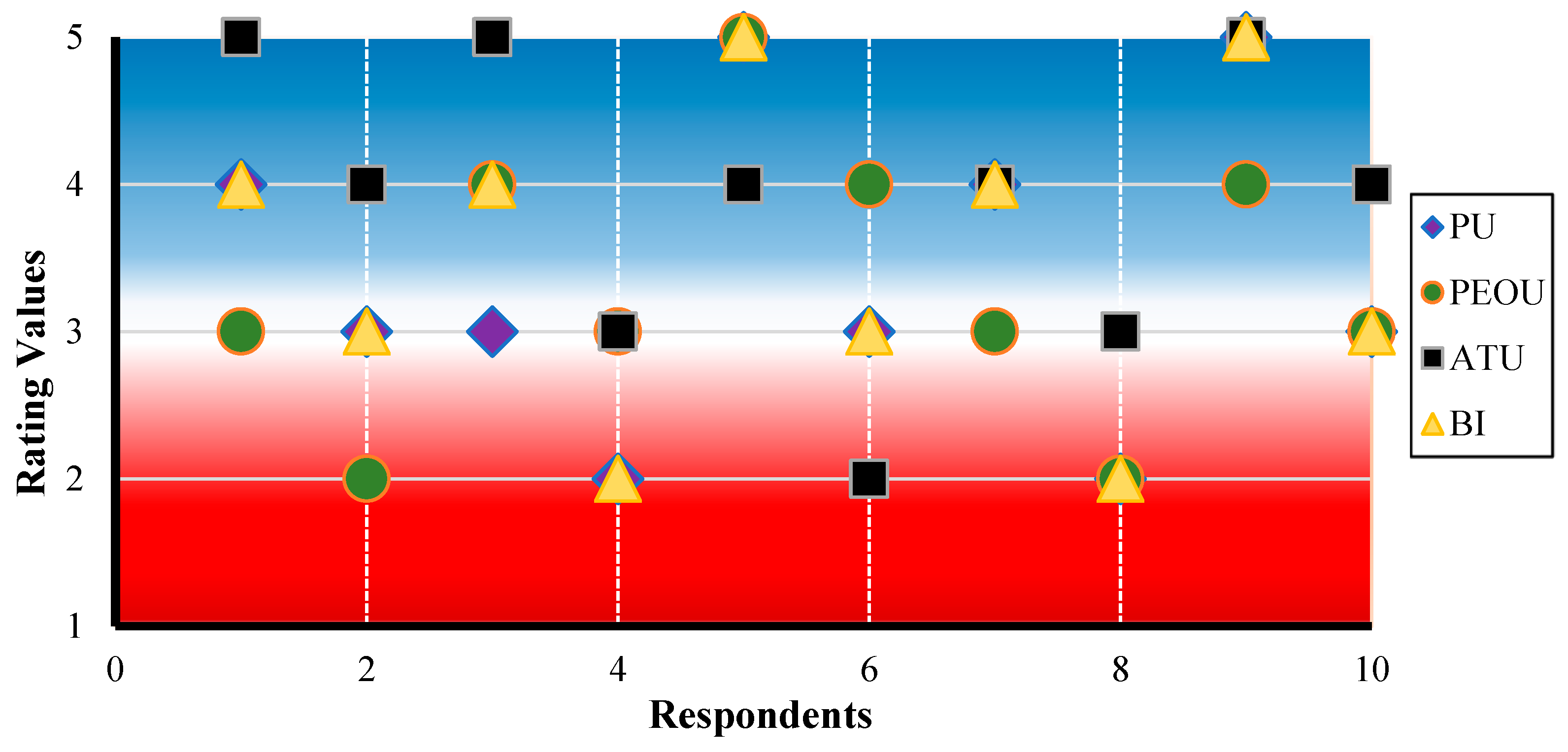
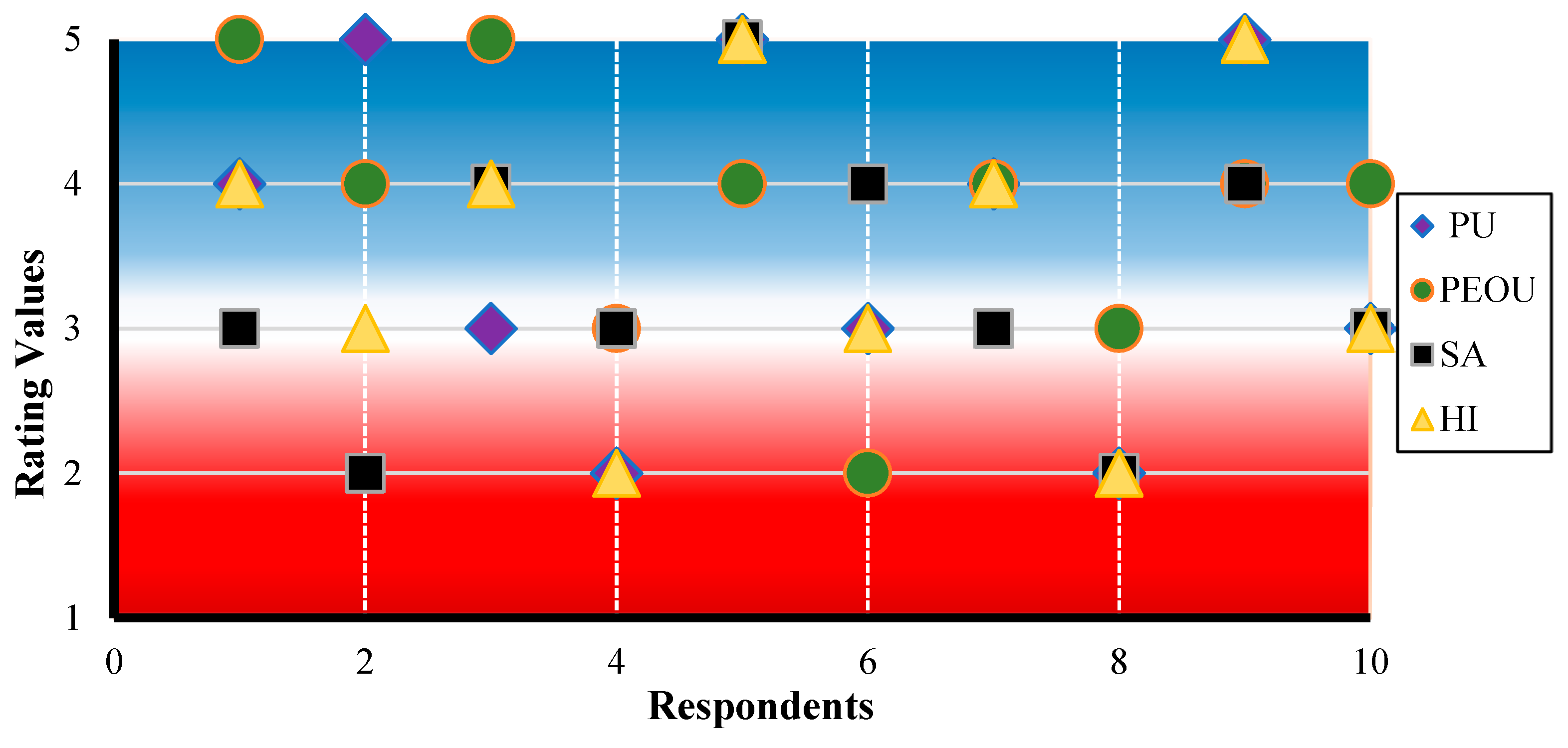
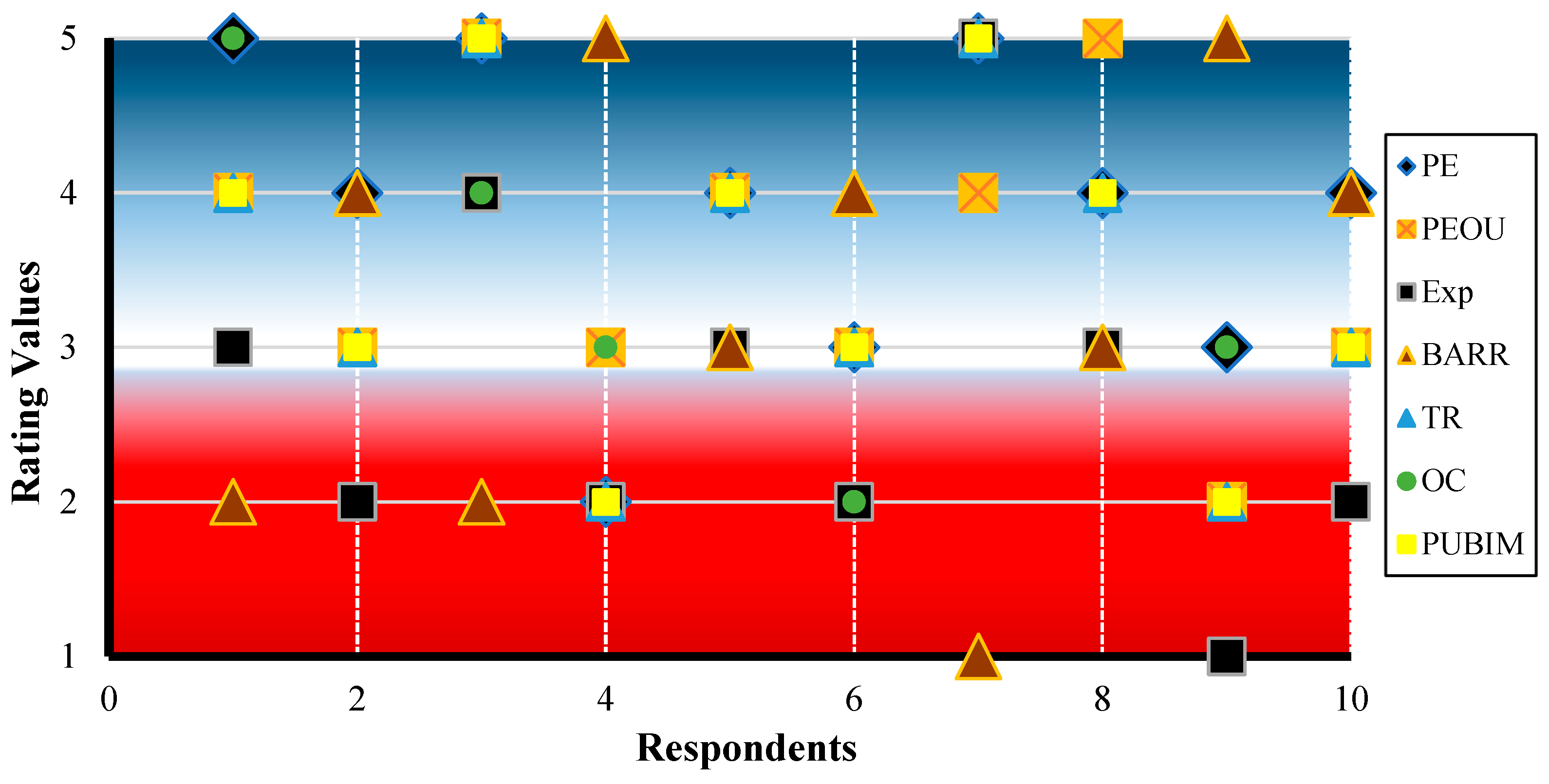
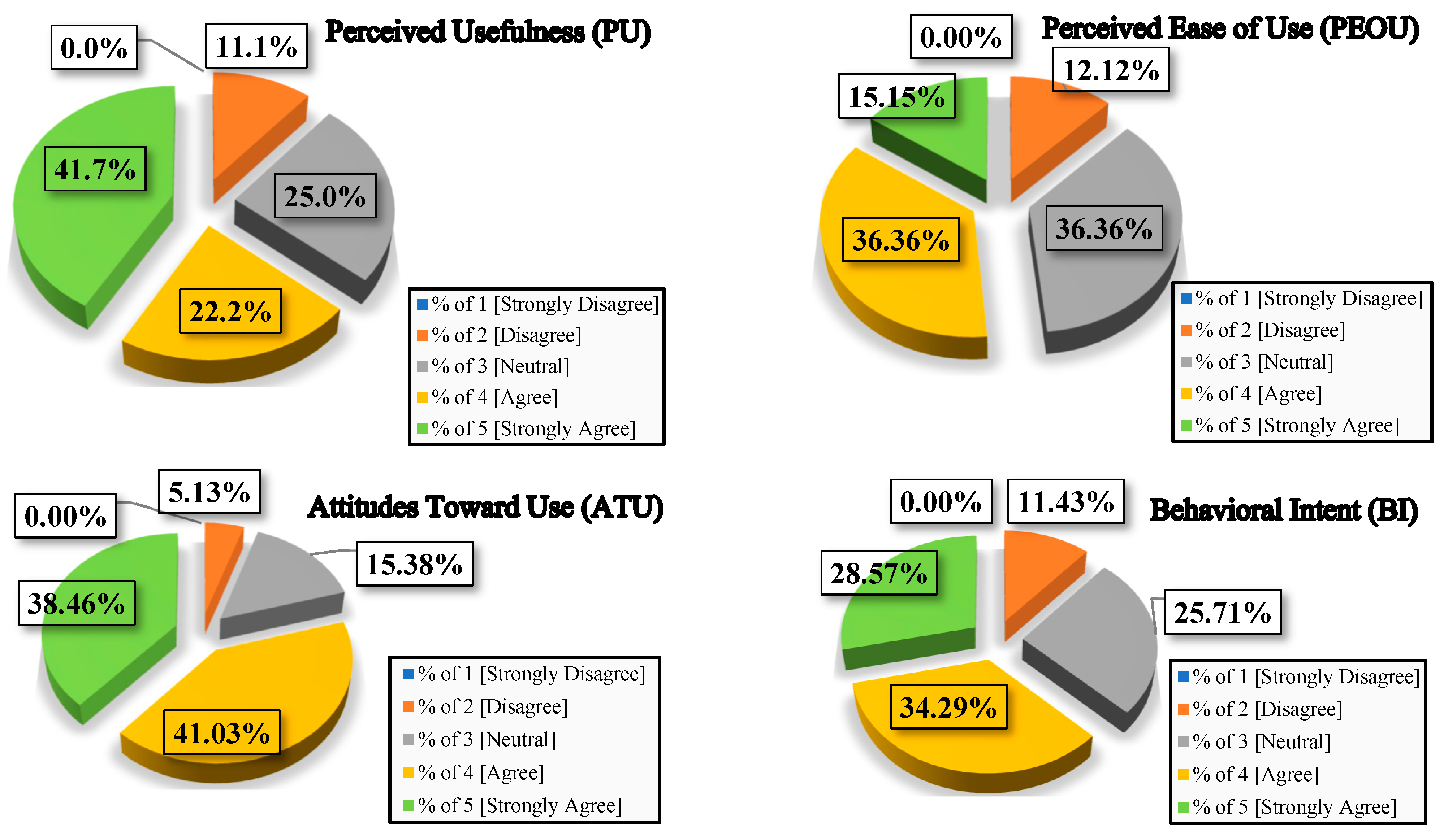


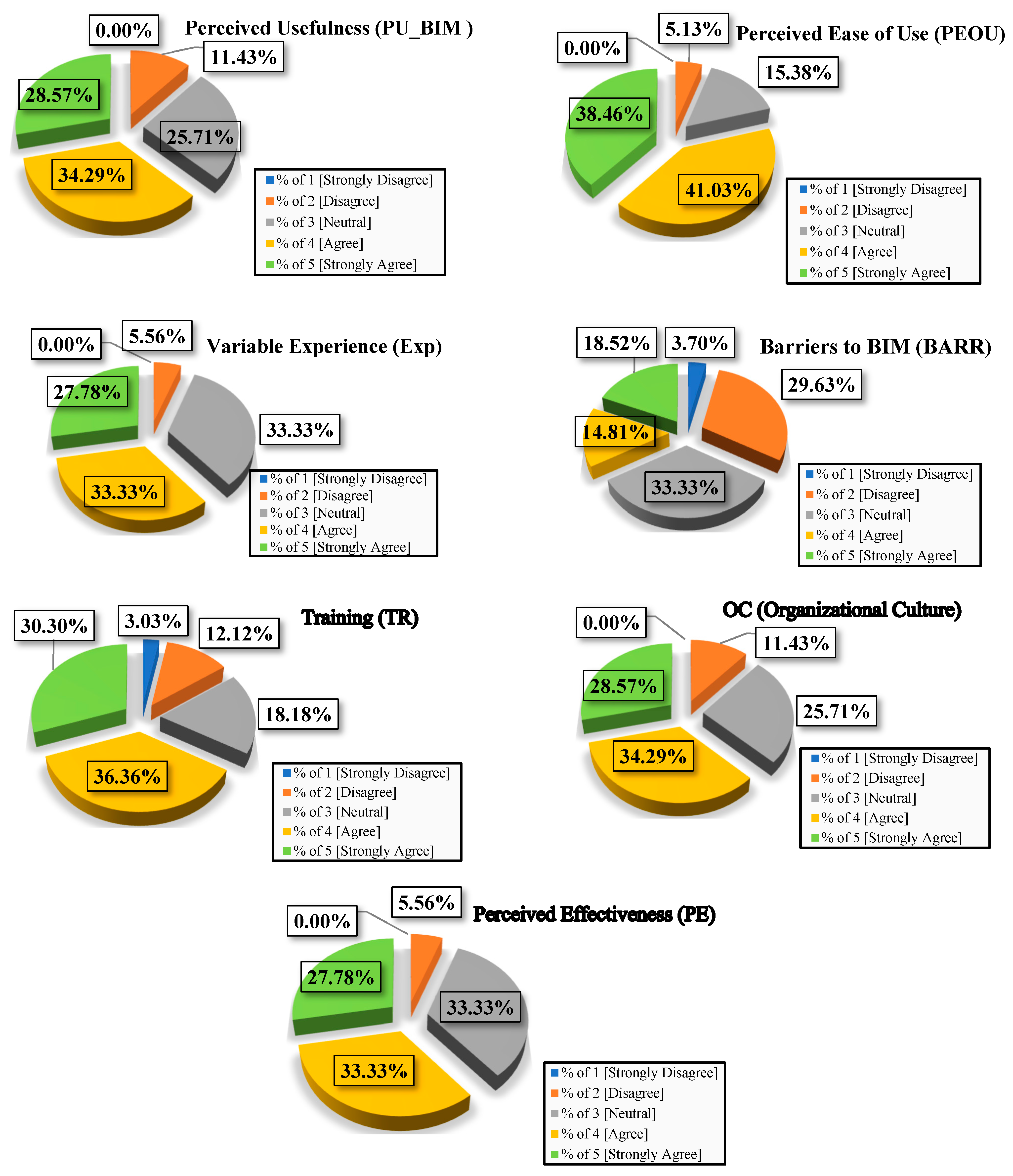
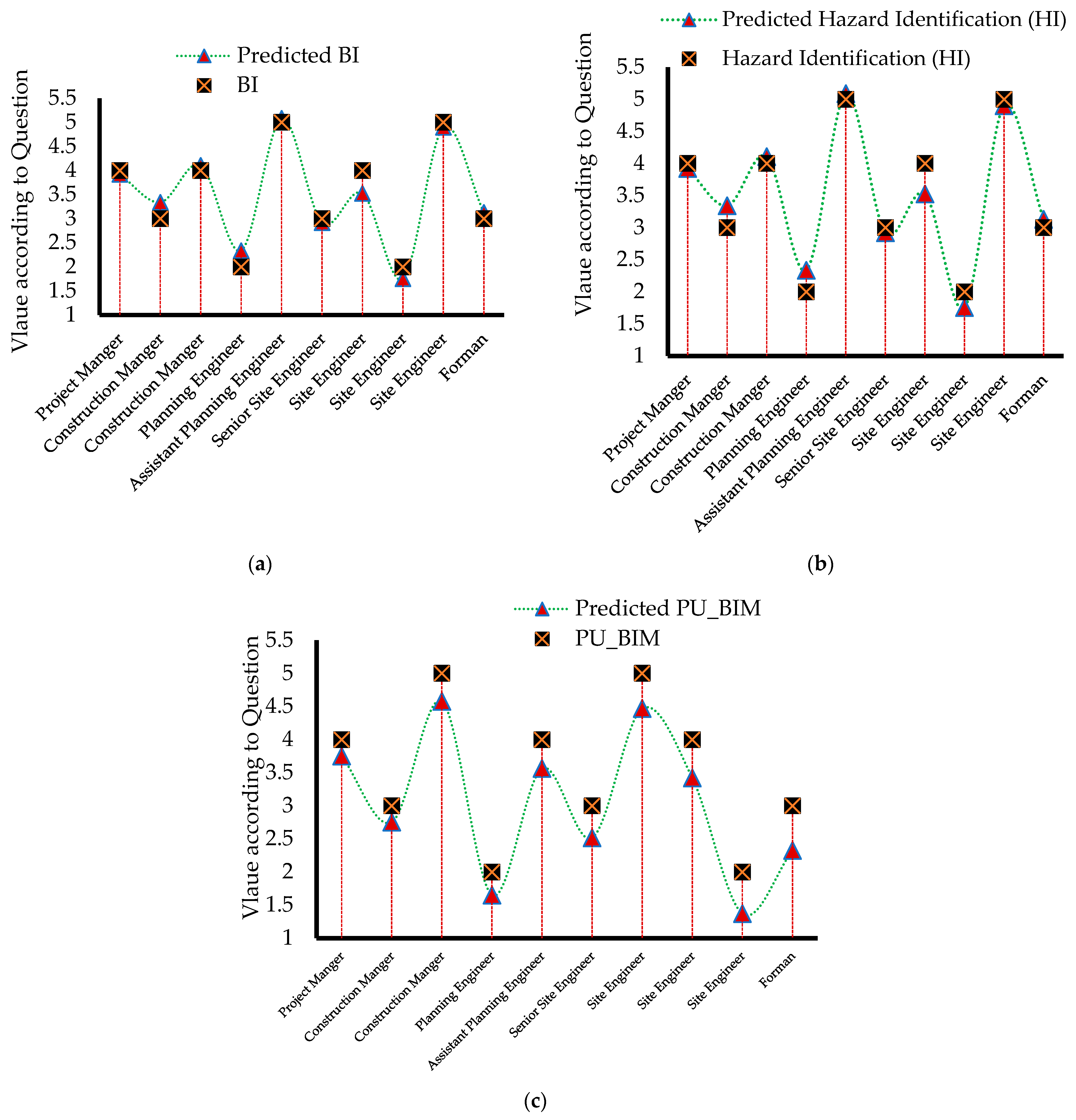
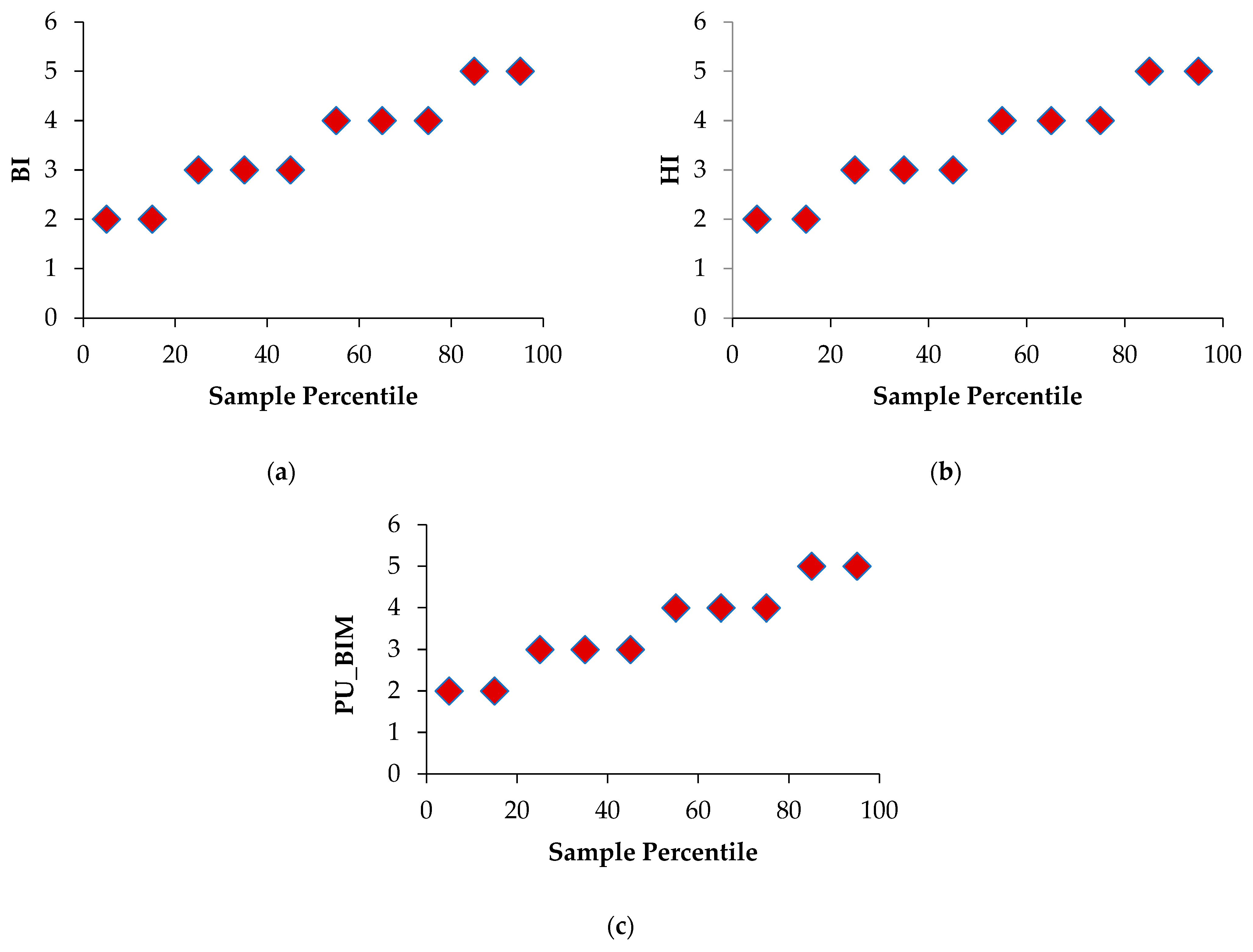

| Names of Authors | Problem Statement | Data Collection | Traditional Method | Advance Method | BIM and TAM |
|---|---|---|---|---|---|
| Mitera-Kiełbasa and Zima, 2025 [41] | High levels of construction waste are affecting cost and timelines | Survey among Polish construction contractors | Conventional waste management strategies | Lean construction and BIM-based waste reduction | BIM supports sustainability and efficiency improvements |
| Salzano et al., 2024 [42] | Issues in technological maturity and stakeholder collaboration | Case studies and stakeholder feedback | Standard project management techniques | BIM for collaborative design and project coordination | BIM enhances communication, reduces errors, and streamlines project workflows |
| Liu et al., 2019 [43] | Limited adoption of BIM in construction management | Screening of 166 peer-reviewed papers | Traditional monitoring/control methods | BIM integration for sustainability, lean construction, and optimization | BIM improves integration, time, and cost management |
| Zou, Kiviniemi, and Jones, 2017 [44] | Limited adoption of BIM for safety in construction | Extensive literature review | Traditional risk management approaches | BIM-based risk mitigation strategies | BIM improves safety management and risk mitigation |
| YC Lin, 2014 [45] | Challenges in technological maturity, talent shortage, and legal regulations | Analysis of BIM applications in various project stages | Standard project management techniques | BIM for collaborative design, clash detection, and schedule management | BIM optimizes efficiency, reduces costs, and enhances project quality |
| Parsamehr et al., 2023 [46] | Difficulty in accessing key construction management data | Literature review and case studies | Conventional project scheduling and cost estimation | BIM-based predictive decision-making framework | BIM enhances communication, collaboration, and automated prediction models |
| Pan and Zhang, 2023 [47] | Complexity and uncertainty in construction projects | Bibliometric analysis and information analysis | Conventional project management techniques | AI-enhanced BIM for automation and digitalization | BIM-AI integration improves efficiency and decision-making |
| García, Rodrigues, and Baptista, 2023 [48] | Challenges in heritage preservation and interoperability | Literature review and case studies | Conventional project management techniques | Digital innovations in architecture, engineering, and construction | BIM improves the technical aspects of conservation and restoration |
| Zhan, Fu, and Wu, 2023 [49] | Issues in interoperability and stakeholder collaboration | Analysis of BIM applications in various project stages | Standard project management techniques | BIM for collaborative design and project coordination | BIM enhances communication, reduces errors, and streamlines project workflows |
| Hire, Sandbhor, and Ruikar, 2022 [50] | Limited adoption of BIM for safety in construction | Bibliometric survey and analysis | Traditional safety management approaches | BIM-based safety planning and predictive hazard identification | BIM improves safety management and risk mitigation |
| Li, Li, and Ding, 2024 [51] | Challenges in interoperability and stakeholder collaboration | Survey of 416 papers from Web of Science | Conventional project management techniques | BIM integration for infrastructure lifecycle management | BIM enhances efficiency, collaboration, and sustainability |
| Respondent Name | Is Perceived Usefulness (PU) of BIM Essential on a Construction Site? (PU) | Is Perceived Ease of Use (PEOU) Essential on a Construction Site? (PEOU) | Is Attitude Toward Use (ATU) Essential on a Construction Site? (ATU) | Is Behavioral Intent (BI) to Adopt BIM for Safety Management Helpful for Construction Work? (BI) |
|---|---|---|---|---|
| Project Manger | 4 | 3 | 5 | 4 |
| Construction Manger | 5 | 2 | 4 | 3 |
| Construction Manger | 3 | 4 | 5 | 4 |
| Planning Engineer | 2 | 3 | 3 | 2 |
| Assistant Planning Engineer | 5 | 5 | 4 | 5 |
| Senior Site Engineer | 3 | 4 | 2 | 3 |
| Site Engineer | 4 | 3 | 4 | 4 |
| Site Engineer | 2 | 2 | 3 | 2 |
| Site Engineer | 5 | 4 | 5 | 5 |
| Forman | 3 | 3 | 4 | 3 |
| Respondent Name | Is Hazard Identification (HI) Essential for a Construction Project? (HI) | Is the Perceived Usefulness (PU) the Extent to Which Stakeholders Believe BIM Can Help Identify Risks and Reduce Construction Risks? (PU) | Is the Perceived Ease of Use (PEOU) the Extent to Which Stakeholders Believe BIM Is Easy to Use for Risk Identification? (PEOU) | Is Safety Awareness (SA) Being Leveled at the Stakeholder Awareness of the Safety Protocols and Risk Reduction Through BIM? (SA) |
|---|---|---|---|---|
| Project Manger | 4 | 5 | 3 | 4 |
| Construction Manger | 5 | 4 | 2 | 3 |
| Construction Manger | 3 | 5 | 4 | 4 |
| Planning Engineer | 2 | 3 | 3 | 2 |
| Assistant Planning Engineer | 5 | 4 | 5 | 5 |
| Senior Site Engineer | 3 | 2 | 4 | 3 |
| Site Engineer | 4 | 4 | 3 | 4 |
| Site Engineer | 2 | 3 | 2 | 2 |
| Site Engineer | 5 | 5 | 4 | 5 |
| Forman | 3 | 4 | 3 | 3 |
| Respondent Name | How Much Does the Impact or Importance of the Perceived Usefulness of BIM for Safety Management in the Construction Sector Matter? (PU_BIM) | Is Perceived Effectiveness of BIM in Risk Identification/Mitigation? PEOU | Is the Perceived Ease of Use of BIM Tools the Extent to Which Stakeholders Believe BIM Is Easy to Use for Risk Identification? (Exp) | What Is the Impact of the Barriers to BIM Adoption (Cost, Technical Complexity, Lack of Training) on Construction Activities? (BARR) | Is Training and Education on BIM Safety Features Essential on a Construction Project? (TR) | What Is the Organizational Culture (Support and Willingness to Adopt BIM) in the Construction Sector? (OC) | Is the Perceived Effectiveness (PE) of BIM in Risk Identification and Mitigation Essential for the Construction Sector? (PE) |
|---|---|---|---|---|---|---|---|
| Project Manger | 4 | 5 | 4 | 3 | 2 | 4 | 5 |
| Construction Manger | 3 | 4 | 3 | 2 | 4 | 3 | 3 |
| Construction Manger | 5 | 5 | 5 | 4 | 2 | 5 | 4 |
| Planning Engineer | 2 | 2 | 3 | 2 | 5 | 2 | 3 |
| Assistant Planning Engineer | 4 | 4 | 4 | 3 | 3 | 4 | 4 |
| Senior Site Engineer | 3 | 3 | 3 | 2 | 4 | 3 | 2 |
| Site Engineer | 5 | 5 | 4 | 5 | 1 | 5 | 5 |
| Site Engineer | 4 | 4 | 5 | 3 | 3 | 4 | 4 |
| Site Engineer | 2 | 3 | 2 | 1 | 5 | 2 | 3 |
| Forman | 3 | 4 | 3 | 2 | 4 | 3 | 3 |
| Description | BI | HI | SP |
|---|---|---|---|
| Sum of Total Variation | 10.41 | 13.65 | 17.89 |
| Number of Questions | 4 | 4 | 7 |
| Cronbach Value | 0.82 | 0.92 | 0.91 |
| Variable | Mean | Standard Error | Median | Mode | Standard Deviation | Sample Variance | Kurtosis | Skewness | Range | Mini. | Max. | |
|---|---|---|---|---|---|---|---|---|---|---|---|---|
| BI | PU | 3.556 | 0.412 | 3 | 5 | 1.236 | 1.527778 | −1.692 | 0.092 | 3 | 2 | 5 |
| PEOU | 3.333 | 0.333 | 3 | 4 | 1 | 1 | −0.643 | 0.107 | 3 | 2 | 5 | |
| ATU | 3.778 | 0.324 | 4 | 4 | 0.972 | 0.944 | −0.009 | −0.502 | 3 | 2 | 5 | |
| BI | 3.444 | 0.377 | 3 | 3 | 1.130 | 1.278 | −1.171 | 0.176 | 3 | 2 | 5 | |
| HI | PU | 3.556 | 0.412 | 3 | 5 | 1.236 | 1.528 | −1.692 | 0.092 | 3 | 2 | 5 |
| PEOU | 3.778 | 0.324 | 4 | 4 | 0.972 | 0.944 | −0.009 | −0.502 | 3 | 2 | 5 | |
| SA | 3.333 | 0.333 | 3 | 4 | 1 | 1 | −0.643 | 0.107 | 3 | 2 | 5 | |
| HI | 3.444 | 0.377 | 3 | 3 | 1.130 | 1.278 | −1.171 | 0.176 | 3 | 2 | 5 | |
| SP | PE | 3.778 | 0.324 | 4 | 4 | 0.972 | 0.944 | −0.009 | −0.502 | 3 | 2 | 5 |
| PEOU | 3.556 | 0.338 | 3 | 3 | 1.014 | 1.028 | −0.763 | 0.270 | 3 | 2 | 5 | |
| Exp | 2.667 | 0.408 | 2 | 2 | 1.225 | 1.5 | 0.349 | 0.816 | 4 | 1 | 5 | |
| BARR | 3.444 | 0.444 | 4 | 4 | 1.333 | 1.778 | −0.153 | −0.661 | 4 | 1 | 5 | |
| TR | 3.444 | 0.377 | 3 | 3 | 1.130 | 1.278 | −1.171 | 0.176 | 3 | 2 | 5 | |
| OC | 3.444 | 0.294 | 3 | 3 | 0.882 | 0.778 | 0.144 | 0.214 | 3 | 2 | 5 |
| Variable | PU | PEOU | ATU |
|---|---|---|---|
| PU | 1 | ||
| PEOU | 0.319298 | 1 | |
| ATU | 0.533067 | 0.153111 | 1 |
| Variable | PU | PEOU | SA |
|---|---|---|---|
| PU | 1 | ||
| PEOU | 0.533067 | 1 | |
| SA | 0.319298 | 0.153111 | 1 |
| Variable | PUBIM | PE | PEOU | Exp | BARR | TR | OC |
|---|---|---|---|---|---|---|---|
| PUBIM | 1 | ||||||
| PE | 0.879284 | 1 | |||||
| PEOU | 0.851835 | 0.647669 | 1 | ||||
| Exp | 0.931541 | 0.741999 | 0.773682 | 1 | |||
| BARR | −0.9614 | −0.89387 | −0.75671 | −0.93857 | 1 | ||
| TR | 1 | 0.879284 | 0.851835 | 0.931541 | −0.9614 | 1 | |
| OC | 0.745356 | 0.763325 | 0.642857 | 0.773682 | −0.8427 | 0.745356 | 1 |
| Regression Statistics | Multiple R | R Square | Adjusted R Square | Standard Error | Observations |
|---|---|---|---|---|---|
| BI | 0.97235975 | 0.9454835 | 0.91822523 | 0.3088752 | 10 |
| HI | 0.97235975 | 0.9454835 | 0.91822523 | 0.3088752 | 10 |
| SP | 0.99900573 | 0.9980125 | 0.74552802 | 0.2618594 | 10 |
| Variable | Coefficients | Standard Error | t-Stat | p-Value | Lower 95% | Upper 95% | Lower 95.0% | Upper 95.0% | |
|---|---|---|---|---|---|---|---|---|---|
| BI | Intercept | −1.392 | 0.5135 | −2.712 | 0.035 | −2.649 | −0.136 | −2.649 | −0.1361 |
| PU | 0.396 | 0.1081 | 3.671 | 0.01 | 0.132 | 0.661 | 0.1323 | 0.661 | |
| PEOU | 0.582 | 0.115 | 5.0823 | 0.002 | 0.301 | 0.862 | 0.301 | 0.862 | |
| ATU | 0.396 | 0.122 | 3.2316 | 0.0178 | 0.096 | 0.695 | 0.096 | 0.69 | |
| HI | Intercept | −1.3928 | 0.5135 | −2.7121 | 0.035 | −2.649 | −0.136 | −2.6493 | −0.1362 |
| PU | 0.3969 | 0.1081 | 3.6708 | 0.0104 | 0.1323 | 0.6615 | 0.1323 | 0.6615 | |
| PEOU | 0.3955 | 0.1224 | 3.2316 | 0.0179 | 0.096 | 0.695 | 0.096 | 0.695 | |
| SA | 0.5822 | 0.1145 | 5.0823 | 0.0023 | 0.3019 | 0.8625 | 0.3019 | 0.8625 | |
| SP | Intercept | −1.10 × 10−15 | 4.28 × 10−16 | −2.67 | 7.50 × 10−2 | −2.50 × 10−15 | 2.2 × 10−16 | −2.50 × 10−15 | 2.10 × 10−16 |
| PE | −8.30 × 10−17 | 4.35 × 10−17 | −1.91 | 1.50 × 10−1 | −2.21 × 10−16 | 5.5 × 10−17 | −2.20 × 10−16 | 5.50 × 10−17 | |
| PEOU | −5.80 × 10−17 | 3.25 × 10−17 | −1.8 | 1.60 × 10−1 | −1.62 × 10−16 | 4.4 × 10−17 | −1.62 × 10−16 | 4.40 × 10−17 | |
| Exp | −6.20 × 10−17 | 4.57 × 10−17 | −1.36 | 2.60 × 10−1 | −2.07 × 10−16 | 8.3 × 10−17 | −2.07 × 10−16 | 8.30 × 10−17 | |
| BARR | 1.10 × 10−16 | 5.60 × 10−17 | 1.9 | 1.40 × 10−1 | −6.70 × 10−17 | 2.8 × 10−16 | −6.77 × 10−17 | 2.80 × 10−16 | |
| TR | 1 | 8.90 × 10−17 | 1.10 × 1016 | 1.60 × 10−48 | 1 | 1 | 1 | 1 | |
| OC | 7.10 × 10−17 | 3.00 × 10−17 | 2.3 | 1.00 × 10−1 | −2.60 × 10−17 | 1.6 × 10−16 | −2.61 × 10−17 | 1.60 × 10−16 |
Disclaimer/Publisher’s Note: The statements, opinions and data contained in all publications are solely those of the individual author(s) and contributor(s) and not of MDPI and/or the editor(s). MDPI and/or the editor(s) disclaim responsibility for any injury to people or property resulting from any ideas, methods, instructions or products referred to in the content. |
© 2025 by the authors. Licensee MDPI, Basel, Switzerland. This article is an open access article distributed under the terms and conditions of the Creative Commons Attribution (CC BY) license (https://creativecommons.org/licenses/by/4.0/).
Share and Cite
Yuan, C.; Awan, A.R.; Khan, A. Construction Safety Management: Based on the Theoretical Approach of BIM and the Technology Acceptance Model. Buildings 2025, 15, 3444. https://doi.org/10.3390/buildings15193444
Yuan C, Awan AR, Khan A. Construction Safety Management: Based on the Theoretical Approach of BIM and the Technology Acceptance Model. Buildings. 2025; 15(19):3444. https://doi.org/10.3390/buildings15193444
Chicago/Turabian StyleYuan, Chen, Afaq Rafi Awan, and Amir Khan. 2025. "Construction Safety Management: Based on the Theoretical Approach of BIM and the Technology Acceptance Model" Buildings 15, no. 19: 3444. https://doi.org/10.3390/buildings15193444
APA StyleYuan, C., Awan, A. R., & Khan, A. (2025). Construction Safety Management: Based on the Theoretical Approach of BIM and the Technology Acceptance Model. Buildings, 15(19), 3444. https://doi.org/10.3390/buildings15193444










